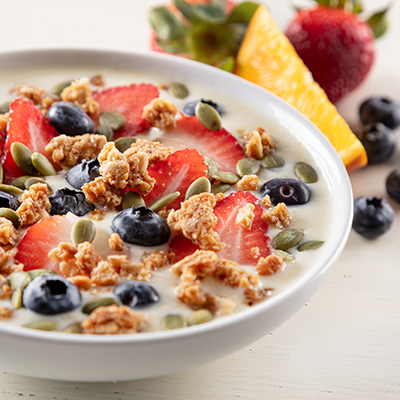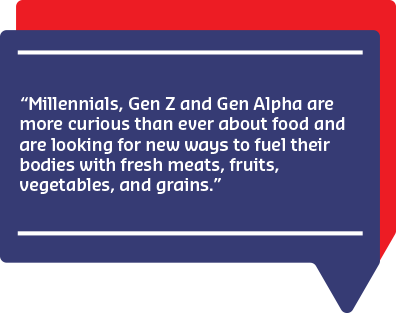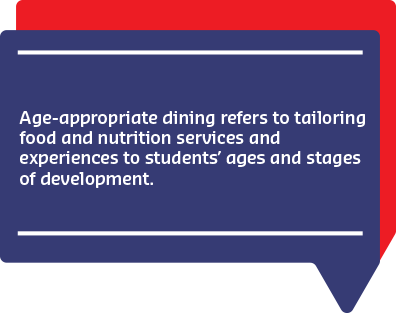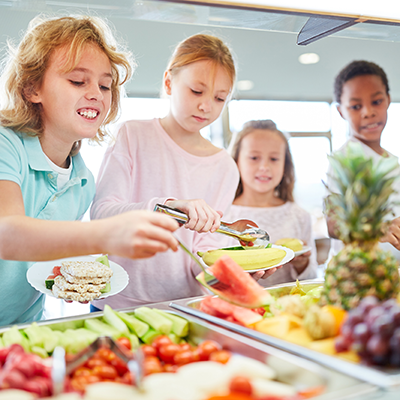Tinfoil-covered square pizza. Sealed plastic trays with peaches, raw carrots and a sugar cookie. A carton of chocolate milk. These are the school lunches some of us may remember from elementary and middle school. But, boy, how school lunches have changed in the last few decades.
 Indeed, today's K-12 lunches look—and taste—quite different. Districts across the county are transforming the unimaginative and bland school lunches of the past into something much more exciting and flavorful for students of all ages. This transformation is driven, in part, by the changing preferences of not only Gen Z and Gen Alpha students, but also their Millennial and Gen X parents. It's also happening because of the dramatic shift in how and what people choose to eat as we all adapt to the “new normal” brought on by the COVID-19 pandemic.
Indeed, today's K-12 lunches look—and taste—quite different. Districts across the county are transforming the unimaginative and bland school lunches of the past into something much more exciting and flavorful for students of all ages. This transformation is driven, in part, by the changing preferences of not only Gen Z and Gen Alpha students, but also their Millennial and Gen X parents. It's also happening because of the dramatic shift in how and what people choose to eat as we all adapt to the “new normal” brought on by the COVID-19 pandemic.
Keeping pace with changing food preferences
According to a 2020 Cassandra Report titled The Picture of Health, today's youth and young adults are seeking dietary experiences that are both highly individualized and more intuitive.1 This means that Gen Z and Millennials are more curious than ever about food and are looking for new ways to fuel their bodies with fresh meats, fruits, vegetables and grains. This omnivore approach to eating also means many young people are saying no to the processed, sugary, fat-ladening foods and restrictive fad diets of the past.
 Not surprisingly, these shifts in eating habits are having a significant impact on the next—and youngest—generation of kids, Generation Alpha. Mark McCrindle, the demographer who coined the name Gen Alpha, describes this highly inquisitive and tech-savvy generation as a “whole new generation, in a whole new millennium, in a whole new era.” Given this, it seems rather fitting that Gen Alpha kids, the oldest of whom are just hitting middle school, are also demanding more unique and diverse foods.
Not surprisingly, these shifts in eating habits are having a significant impact on the next—and youngest—generation of kids, Generation Alpha. Mark McCrindle, the demographer who coined the name Gen Alpha, describes this highly inquisitive and tech-savvy generation as a “whole new generation, in a whole new millennium, in a whole new era.” Given this, it seems rather fitting that Gen Alpha kids, the oldest of whom are just hitting middle school, are also demanding more unique and diverse foods.
According to McCrindle, Gen Alphas will consume fewer soft drinks and will be much more apt to explore plant-based proteins and non-dairy options.2 In addition, McCrindle says this younger generation will be more concerned about calories and portion sizes and will rely heavily on monitoring devices to track their food intake and exercise.
Now, some may scoff at the idea of K-12 schools serving kids ginger turkey tacos or quinoa bowls and fruit smoothies, but the reality is that the changing preferences of students—and their parents—are driving a massive change in how we approach school meals. Today's Gen Alpha students expect not just their learning to be highly personalized, but also other experiences like their school lunches.

Graphic: Millennials, Gen Z and Gen Alpha are more curious than ever about food and are looking for new ways to fuel their bodies with fresh meats, fruits, vegetables, and grains.
Ushering in a new era of age-appropriate dining
I'm proud to say that Sodexo is on the leading edge of this transformation. Our teams recognize the importance of tailoring food and nutrition services to students' ages and stages of development. This focus on age-appropriate dining starts very early with elementary school kids and continues through high school. It might be introducing vegetables in creative ways to K-5 students. Or making and presenting food that appeals to the inquisitive minds of middle schoolers. Or preparing high schoolers to make healthier food choices now and in college. All these efforts help students embrace a lifelong journey of health and wellness.

Graphic: Age-appropriate dining refers to tailoring food and nutrition services and experiences to students' ages and stages of development.
Stanford Children's Health further supports the idea of age-appropriate dining, advocating children between the ages of six and 12 need four to five nutritious meals and snacks each day to fuel their steady, but slow rate of growth.3 They also remind us that children this age are incredibly impressionable and form many food likes and dislikes during this time. Because of this, it's important for schools across the country to take an active role in helping children explore many different options and develop healthy eating habits.
It's a concept we've long sought solutions for and we're pleased to be rolling out our new foodiE Café to more than 600 middle schools nationwide over the next two years. This new integrated dining experience allows sixth, seventh and eighth graders to enjoy all their favorite foods, while having opportunities to explore global flavors, discover sustainable alternatives and gain a better understanding of local products. It's just one of many ways we're supporting age-appropriate dining in K-12.
Age-appropriate dining: Beyond just dietary desires
 Age-appropriate dining isn't just about the food itself, though. It's also about meeting the changing expectations of students in how they get their food, and when. Take middle schoolers for example. Most sixth through eighth graders view their lunch period as more than a time to grab a quick bite to eat. They see it as a time to connect with their friends. Because of this, the speed at which they can get their lunch is increasingly important.
Age-appropriate dining isn't just about the food itself, though. It's also about meeting the changing expectations of students in how they get their food, and when. Take middle schoolers for example. Most sixth through eighth graders view their lunch period as more than a time to grab a quick bite to eat. They see it as a time to connect with their friends. Because of this, the speed at which they can get their lunch is increasingly important.
Integrated technology, like the SoHappy app, not only gives students the nutritional information they need to make educated decisions about what they eat, but also the power to pre-order their food with the click of a button. Couple this technology with innovative menu options, age-appropriate school nutrition curriculum, and social media interaction with that content, and you have a winning combination for kids!
Another big component of age-appropriate dining is addressing the convenience factor. The Cassandra Report shows that today's Gen Z and Millennials—and Gen Alpha for that matter—are gravitating toward what it calls “snackable” customization, or a hybrid and individualized approach to food.
In the beginning of the pandemic, there was a rush to consume indulgent, nostalgic treats like waffles, cereals, cookies and crackers. In fact, The New York Times reported a 30% jump in sales of these types of unhealthy snacks in the early days of COVID-19.4 However, that pace has slowed as more young people have settled into new routines over time. Today, they're balancing indulgences with nutritious foods that boost their overall health and wellbeing during this extended period of uncertainty. And with these new routines, come some interesting food microtrends.
Emerging dietary microtrends
According to the Cassandra Report, there are several food microtrends that young consumers find attractive. For this article, I'll highlight three key trends emerging among youth: a focus on indigenous food and techniques, an interest in fasting and a draw toward do-it-yourself (DIY) meal kits.
-
Indigenous food and techniques
As the world becomes more diverse, there's an increasing desire to bring the food, flavors, techniques and traditions of various cultures to life in households—and schools—across the country. According to Pew Research Center, Hispanics comprise nearly 18% of the U.S. population, making them the largest minority ethnic group in the nation at nearly 60 million people. Hispanics are also well represented in K-12 public schools across the country, making up 28% of the total student population. With more than one in four students with a Hispanic background, it's no wonder that school districts everywhere are seeking innovative ways to bring the Hispanic culture into mealtimes. We highlighted one such example recently, where the food services team at Balsz Elementary in Phoenix consistently creates dishes made from traditional foods that reflect its students' diverse heritages.
-
Fasting
Another popular trend that taking the world by storm is fasting, or as some might call it, intermittent fasting. This practice, where you abstain from eating for a set period, is said to promote weight loss and improve metabolic health. And while the benefits of fasting are still being debated, one thing is clear: one in four youth is already doing it or is interested in trying it, according to Cassandra. For some, this triggers alarm bells. That's because many dietitians argue that there's not enough evidence to recommend fasting for children, in part, because kids are in a rapid period of growth and require an increased amount of nutrients. This is yet another reason why districts across the country need to remain vigilant in their efforts to increase access to many different nutritious food options. It's even more important that schools provide nutrition-related curriculum to help students understand the impact food has on their growing bodies so they can build healthy eating habits for life.
-
Meal kits
The third and last microtrend is a heavy interest on DIY meal kits. These kits, like the ones being offered to college students through a partnership between Sodexo and HelloFresh, come with all the ingredients and instructions you need to make a healthy, delicious meal at home. This trend relates to school-aged children for two reasons. First, if you have children, you can involve them in making meals like these for your family. This, in turn, raises their awareness about what goes into a healthy meal—like the calorie count, amount and types of fat, number of carbohydrates and nutrients. Second, these kits provide many options for bringing flavor and flair into your kitchen, many of which reflect different heritages, cultures and traditions. Kids who are accustomed to having these types of meals at home will naturally expect—and gravitate toward—a similar experience at school.
Evolving school meals market
Middle schoolers today are highly diverse and are much more curious and adventuresome in their food preferences than in years past. Staples like chicken nuggets, pizza and nachos—while still available for when those cravings hit—simply aren't enough to satiate their demands for better, more wholesome meals. Instead, they're seeking more specialty, vegetarian and even vegan options that provide a more enriching lunchroom experience. Meeting kids where they are in life and providing them with meals that fuel both their developing brains and bodies is important work. I hope you will join in the conversation and continuing advocate for more age-appropriate dining options nationwide.
Sources
1 2020 Cassandra Report: The Picture of Health

